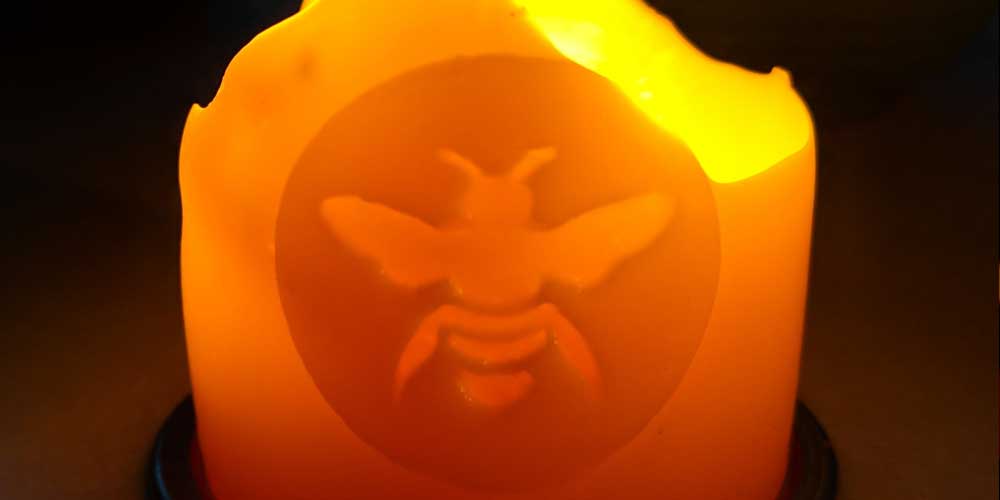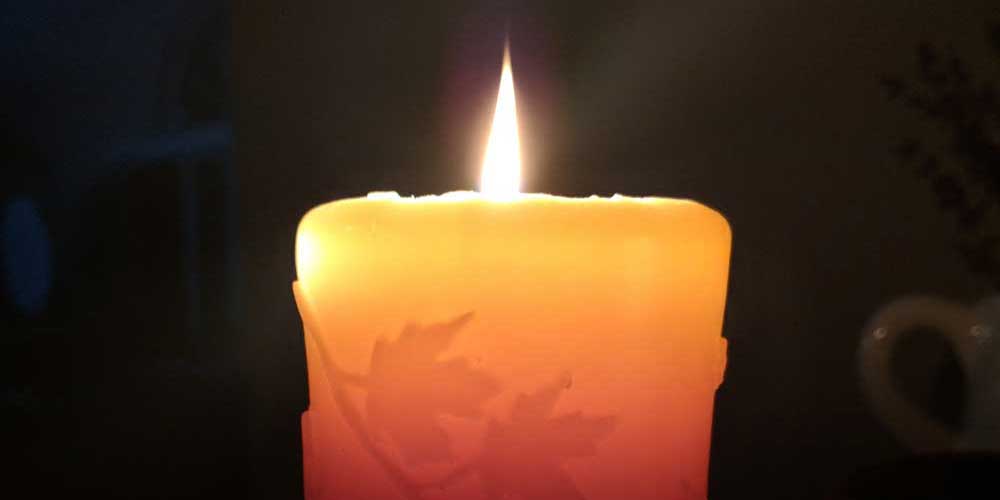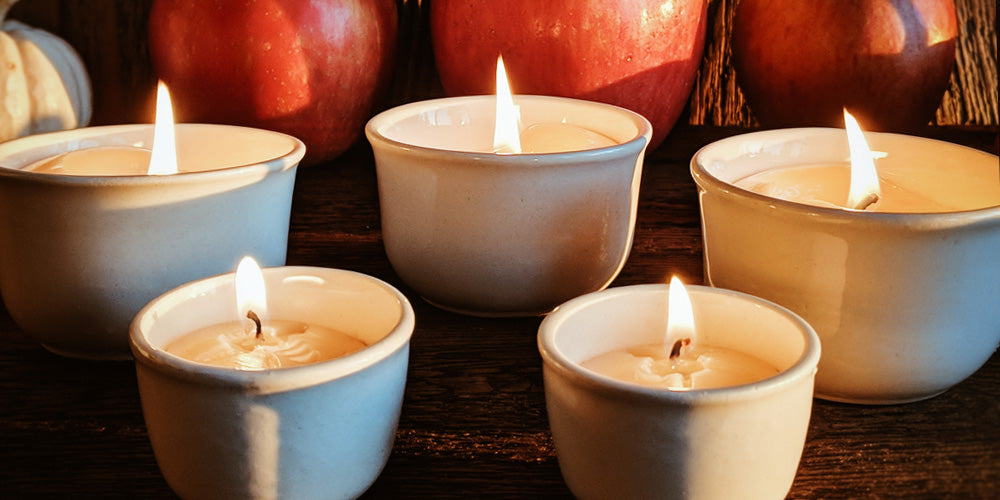Beeswax: the only wax in the world that doesn't need humans to make it. Nature's original and true natural candle wax. Unlike all other types of candle waxes available to candle-makers, only beeswax is made naturally, by the bees themselves. You can take beeswax straight from a beehive, rinse out the honey and make a candle. You can't do that with a soybean, palm tree, coconut and most definitely not with petroleum. Soy, palm, coconut, paraffin, all must be converted from their original state and turned into an oil and then made into a wax. This takes place in factories that use formulas to achieve a consistent result each time. Bees however, don't need machinery or additives to make wax. They also don't need artificial fragrances to make their wax smell good since they use natural fragrance from of all the flowers and plants they forage on to scent their wax. Nature's perfect little pollinators are also nature's perfect little wax makers.
EACH BATCH OF BEESWAX IS DIFFERENT
 A lot of new beeswax candle-makers are surprised and frustrated when they start making beeswax candles because they think it’s going to be much easier than using other types of waxes. Just melt beeswax, pop in a wick and voila! you have a candle! Nope, not that easy. Even though beeswax does not need additives like UV stabilizers, hardening agents, preservatives and fragrance, you would think it would be an easier wax to work with, but it isn’t. Beeswax has natural variables that waxes made with consistent formulas in a factory do not have. Beeswax is different for several reasons:
A lot of new beeswax candle-makers are surprised and frustrated when they start making beeswax candles because they think it’s going to be much easier than using other types of waxes. Just melt beeswax, pop in a wick and voila! you have a candle! Nope, not that easy. Even though beeswax does not need additives like UV stabilizers, hardening agents, preservatives and fragrance, you would think it would be an easier wax to work with, but it isn’t. Beeswax has natural variables that waxes made with consistent formulas in a factory do not have. Beeswax is different for several reasons:
HONEY BEE FORAGING REGIONS
 Bees forage wherever they live (if they didn’t, our world would be in a lot of trouble!) and each honeybee region provides different plants and flowers for them to forage on. This will affect the fragrance of the wax. Beeswax obtained from other parts of the country will smell differently, depending on what the bees foraged on. The same holds true for all the flavors of honey. Since Big Moon Beeswax obtains our beeswax directly from beekeepers here in the Pacific Northwest, we know what our honeybees were foraging on and select our wax because of the fragrance it provides. So how your beeswax candles smell will be different from one candle company to another, depending on where they purchased their beeswax.
Bees forage wherever they live (if they didn’t, our world would be in a lot of trouble!) and each honeybee region provides different plants and flowers for them to forage on. This will affect the fragrance of the wax. Beeswax obtained from other parts of the country will smell differently, depending on what the bees foraged on. The same holds true for all the flavors of honey. Since Big Moon Beeswax obtains our beeswax directly from beekeepers here in the Pacific Northwest, we know what our honeybees were foraging on and select our wax because of the fragrance it provides. So how your beeswax candles smell will be different from one candle company to another, depending on where they purchased their beeswax.
Check out this interesting Honeybee Forage Regions Map provided by NASA!
WAX PROCESSING DURING HONEY HARVESTING
 Another huge factor (one of the most important!) is how the beeswax was handled by the beekeeper or honey processor during honey harvesting. Conscientious beekeepers treat their beeswax like the gold that it is and handle it carefully while removing the honey from the wax. If your candle-maker obtained their beeswax from a source that treated the wax gently, the beeswax will still retain its beautiful natural honey scent and color. If the wax was treated with too much heat or near too much smoke, the wax can loose its fragrance and turn the wax a darker color. Most experienced beeswax candle-makers will have found a reliable and beautiful beeswax source that they trust.
Another huge factor (one of the most important!) is how the beeswax was handled by the beekeeper or honey processor during honey harvesting. Conscientious beekeepers treat their beeswax like the gold that it is and handle it carefully while removing the honey from the wax. If your candle-maker obtained their beeswax from a source that treated the wax gently, the beeswax will still retain its beautiful natural honey scent and color. If the wax was treated with too much heat or near too much smoke, the wax can loose its fragrance and turn the wax a darker color. Most experienced beeswax candle-makers will have found a reliable and beautiful beeswax source that they trust.
To read more about the colors and fragrances of beeswax, feel free to read our blog post on 'Why Beeswax Color Varies'.
WAS THE BEESWAX PROCESSED BY ANOTHER METHOD?
 Some candle-makers buy their beeswax in large quantities from apiaries and they usually come in big blocks of wax that will need to be filtered by the candle-maker before using for candle crafting. Another way to obtain beeswax for candle-making is to purchase it from wax re-sellers that take the wax from the apiary and turn it into smaller wax blocks or wax pellets. Wax pellets are a lot easier to handle than huge wax blocks and they are ready to melt and use without any additional filtering by the candle-maker. This type of wax has its own type of scent as re-sellers obtain their wax from all over the United States and even overseas. Beeswax re-sellers have their proprietary methods of taking raw beeswax and turning it into pellets, but as long as the wax is labelled 100% pure beeswax, then candle-makers can feel somewhat comfortable that they are getting 100% Pure Beeswax and not beeswax cut with less expensive wax.
Some candle-makers buy their beeswax in large quantities from apiaries and they usually come in big blocks of wax that will need to be filtered by the candle-maker before using for candle crafting. Another way to obtain beeswax for candle-making is to purchase it from wax re-sellers that take the wax from the apiary and turn it into smaller wax blocks or wax pellets. Wax pellets are a lot easier to handle than huge wax blocks and they are ready to melt and use without any additional filtering by the candle-maker. This type of wax has its own type of scent as re-sellers obtain their wax from all over the United States and even overseas. Beeswax re-sellers have their proprietary methods of taking raw beeswax and turning it into pellets, but as long as the wax is labelled 100% pure beeswax, then candle-makers can feel somewhat comfortable that they are getting 100% Pure Beeswax and not beeswax cut with less expensive wax.
 Some larger candle companies import their wax directly from China for cost savings and as long as the candle companies have good quality inspectors over there to make sure the wax is pure and not cut with less expensive waxes, then that should be fine for candle-making. Beeswax imported from China is much less expensive than beeswax sourced from North America and allows the candle companies to sell their candles at very competitive prices. If the beeswax candle you purchase is much less expensive than any others out there, you may have reason to believe they are using wax sourced from overseas because there's not enough profit margin available to afford deep discounts and frequent sales using higher end wax. Ethical, experienced candle companies will make sure to use wax that is safe, and hopefully be upfront about whether their beeswax candle is 100% beeswax or a blend.
Some larger candle companies import their wax directly from China for cost savings and as long as the candle companies have good quality inspectors over there to make sure the wax is pure and not cut with less expensive waxes, then that should be fine for candle-making. Beeswax imported from China is much less expensive than beeswax sourced from North America and allows the candle companies to sell their candles at very competitive prices. If the beeswax candle you purchase is much less expensive than any others out there, you may have reason to believe they are using wax sourced from overseas because there's not enough profit margin available to afford deep discounts and frequent sales using higher end wax. Ethical, experienced candle companies will make sure to use wax that is safe, and hopefully be upfront about whether their beeswax candle is 100% beeswax or a blend.
SO HOW DO I KNOW WHERE THE WAX COMES FROM WHEN I BUY A BEESWAX CANDLE?
Well, unless your candle company of choice tells you where they get their wax, you won’t know for sure. You can always ask them if the source is important to you. The best thing to do is to try out a candle, see if it burns beautifully and if you like its fragrance. Experienced candle-makers will not sell poor quality candles if they want to stay in business, so let your eyes and nose decide if you like what you’ve purchased. Just know that if your candle-maker has an amazing beeswax source, they most likely won’t want to give out that information as it’s like a secret ingredient that makes their candles special. They should tell you the general origin of how they obtain their wax for your peace of mind though. Here at Big Moon Beeswax, we have two dedicated beeswax sources that we love because we’ve been to their apiaries and seen the wax firsthand. One source is right here in the Pacific Northwest and the other is further out in the United States. We use several apiaries so we can vary the color and the fragrance of our candles.
Experienced candle-makers will not sell poor quality candles if they want to stay in business, so let your eyes and nose decide if you like what you’ve purchased. Just know that if your candle-maker has an amazing beeswax source, they most likely won’t want to give out that information as it’s like a secret ingredient that makes their candles special. They should tell you the general origin of how they obtain their wax for your peace of mind though. Here at Big Moon Beeswax, we have two dedicated beeswax sources that we love because we’ve been to their apiaries and seen the wax firsthand. One source is right here in the Pacific Northwest and the other is further out in the United States. We use several apiaries so we can vary the color and the fragrance of our candles.
As you can see from reading our How to Buy the Best Beeswax Candles blog series, there are too many variables out there to make one candle-maker the BEST. Exaggerated marketing claims guaranteeing that their candles are the best beeswax candles you can buy is not realistic or fair to the consumer. Since we breathe what we burn, candle makers need to be as open and honest with their customers as they can without giving away proprietary information. As candle makers and sellers, we owe our customers straightforward information so they can make the best choices for their needs. Hopefully, our continuing blog posts on the subject will help candle buyers understand why there are so many good beeswax candle-makers out there and why you may prefer one over another.
Thank you for taking time to read this blog post and please check out parts one and three!
Bee Cozy



